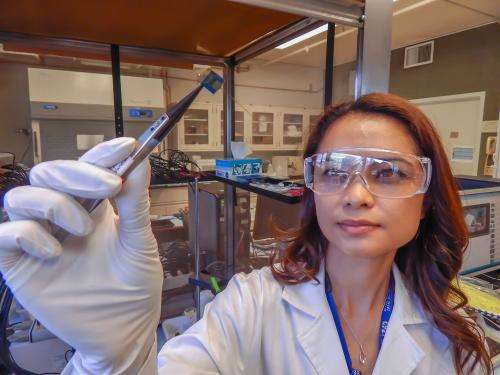Understanding how the brain retrieves memories

(Medical Xpress)—Livermore scientists are developing electrode array technology for monitoring brain activity as part of a collaborative research project with UC San Francisco to better understand how the neural circuitry of the brain works during memory retrieval.
The long term goal of the research is a deeper understanding of the brain's memory processes so physicians can better treat such diseases as Alzheimer's, post-traumatic stress syndrome, schizophrenia and depression as well as finding ways to optimize cognitive function.
The Livermore team, led by principal investigator Vanessa Tolosa, is leveraging previous LLNL work on the artificial retina project to develop and apply a biologically compatible technology capable of recording from thousands of neurons over years, a quantum improvement over what is currently possible. Funded by the University of California Office of the President (UCOP) for three years, the overall project is led by Loren Frank of UC San Francisco.
Tolosa's group is applying Livermore's experience and the Center for Micro and Nano Technologies' unique facilities for fabricating, assembling and testing biomedical devices.
This new generation electrode technology is being designed for compatibility with optogenetic stimulation, a technique for using light sensitive proteins and light to precisely manipulate neural activity, Tolosa said. Optogenetic stimulation allows researchers to target specific kinds of neurons or cells.
While scientists understand that many regions of the brain are important for different functions, they do not as yet understand the patterns of neural activity that underlie processes such as learning, memory, decision making and action, she noted.
These processes depend not just on one area of the brain but on the interaction of many regions, each containing hundreds of thousands or even millions of neurons that communicate with one another in milliseconds of time, Tolosa said. "The patterns of interaction are very complex. Learning and memory, for example, involve communication over many parts of the brain."
But recording these complex interactions is not a simple matter. The Livermore team is developing a biocompatible flexible polymer array, similar to the one used in the artificial retina, but with the addition of the embedded optical guides needed to probe and record neural activity. In addition LLNL is developing a custom connector that will integrate the array with the data acquisition electronics being developed by Loren Frank's lab at UCSF.
Tolosa says the challenge is to develop an array that can penetrate regions of the brain without interfering with the normal brain function of the animals being studied. "The penetrating electrodes have to reach the deep regions of the brain. We think that with our technology we can make these penetrating arrays small, flexible and minimally invasive."
The recording arrays with embedded light guides developed by LLNL will be combined with the package of electronics that amplify and process recorded signals on the animal's head, called the headstage, developed in collaboration with UCSF. Implantation and testing of the arrays is being conducted at UCSF.
A year into the project the array technology is showing promise in early tests on animals. A 36- electrode array was able to continually record rodent brain activity for at least two months, a significant improvement over previous recordings by the UCSF lab lasting only a few days, Tolosa said. "The results have been good so far."
The next step will be to implant multiple 36-electrode, or channel, arrays to eventually build up to 127 and even 500 in the first three years of the project. A long term goal is to develop a 1,000 channel array, which researchers believe what would be required to study neural activity across multiple regions of the brain in sufficient detail.
With this technology, researchers can then begin to put the pieces together of how the different regions of the brain store an event as memory, later recalls that memory and how it uses that memory to make decisions. The members of Tolosa's group include Sat Pannu, Kedar Shah, Sarah Felix, Angela Tooker, Kye Lee, Supin Chen and Elaine Behymer.
"This collaboration draws on the strengths and expertise of each Laboratory," Pannu said. "Neither lab has the technology or expertise to develop these tools and techniques alone."
"We believe that this collaboration will produce new science and technology that will benefit the larger brain research community," Pannu said.
Provided by Lawrence Livermore National Laboratory



















